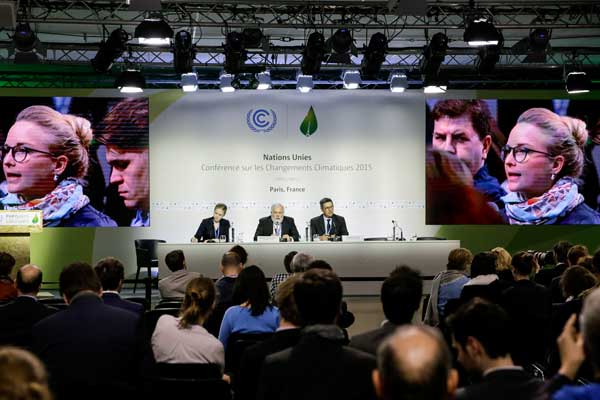
Climate change after Paris: “there has to be a freeze on further development of the tar sands”
Published: December 15, 2015
After two weeks of negotiations, delegates at the UN climate conference in Paris adopted what many are calling an historic climate-change agreement.
While many are saying the pact adopts a more ambitious target for global warming than previous treaties, the Paris agreement does not call for “reaching greenhouse gas emissions neutrality in the second half of the century,” initial language that faced resistance by oil-producing countries.
The University of Toronto's Munk School of Global Affairs and the Faculty of Law will host a panel discussion called After the Paris Climate Summit: What Now? on Wed. Dec. 16 on the agreement with experts from the department of political science and the Faculty of Law, as well as Greenpeace.
In the meantime, Professor Danny Harvey of geography in the Faculty of Arts & Science, who talked to U of T News at the outset of the Paris talks, returns to share his opinions on the new agreement and whether the world can actually limit global warming to 2 degrees Celsius.
There's been a lot of praise for the deal but also criticism that it’s short on detail.
The Paris agreement does not provide any legally binding quantitative targets or timetables for reductions of greenhouse gas emissions by any individual nations, and provides only the most general and vague targets at the global level. It does, nevertheless, represent a useful strengthening of the pre-existing framework that can in turn be used to pressure individual governments to take meaningful action.
In particular, the agreement calls for peaking of global emissions “as soon as possible,” “rapid reductions thereafter in accordance with the best available science”, and achieving a “balance between anthropogenic emissions by sources and removals by sinks of greenhouse gases in the second half of this century.” This language implies that emission reductions should be sufficiently large that greenhouse gas concentrations are stabilized sometime between 2050 and 2099. In the case of carbon dioxide emissions, this implies an absolute reduction, compared to current global levels, of around 50 per cent sometime between 2050 and 2099, with further reductions as natural sinks gradually weaken, and faster and deeper reductions if natural sources become larger due to various feedbacks between global warming and natural emission sources.
This is stronger than previous agreements, although I would have preferred one of the bracketed variants in an earlier draft – calling for anthropogenic carbon dioxide emissions to reach zero by 2060 to 2080 – to be in the final draft.
Does the agreement get us under the 2 degree target?
As for the discussion as to whether to adopt a 1.5 degrees Celsius or a 2.0 degrees Celsius target, the whole discussion is a bit meaningless because the climate system is not like some machine where one can just choose the setting that one wants. It could be that we eliminate fossil fuel emissions within this century and we end up with 4 degrees Celsius warming, or we could be lucky and – at the other extreme – end up with only 1.5-2.0 degrees Celsius warming. The only thing we can directly control are our emissions; nature will decide what that translates into.
Is 2.0 degrees Celsius or any other particular warming safe?
No. Even 1.0 and 1.5 degrees Celsius warming could eventually lead to several meters sea level rise, and lead to widespread ecosystem damage (much of which would occur after a long time delay). With close to 1.0 degrees Celsius global mean warming, we are already seeing increasing drought and water stress in many regions. There is no scientific basis for saying that even 1.0-1.5 degrees Celsius warming levels are completely safe. However, the risks grow the larger the warming.
On the other hand, 2.0 degrees Celsius is not some threshold beyond which impacts suddenly turn catastrophic. Things could already be quite bad by 2.0 degrees Celsius, and worse still with further warming. So … all we can do at this stage is reduce emissions as fast as possible (and how fast is “possible” depends in large part on how hard we try), hope for the best, and prepare for the worst. What we can also do is continue to point out to governments the implications, in terms of national emission targets and investments, of the 1.5-2.0 degrees Celsius warming target that they have agreed to.
What does the agreement mean for Canada?
In Canada, a clear implication is that there has to be a freeze on further development of the tar sands, accompanied by reductions in per barrel emissions and development of some plan for their phase-out by mid-century. This needs to be accompanied by a phase-out of coal for electricity production (which has already been done in Ontario and agreed to by Alberta) and later by natural gas too, significant improvements in the efficiency of the transportation fleet along with uptake of electric and other alternative vehicles, rapid improvements in building codes, and retrofitting much of the existing building stock to reduce energy use by factors of 2-3.
If the world is serious about what it has just agreed to, the demand for expensive and C-intensive [carbon-intensive] fossil fuel fuels will be falling rapidly over the coming decade, so we will really have no choice but to wean our economy off of exports of fossil fuels. This implies no construction of new pipelines, which would have an economic lifespan of 40 to 60 years – to carry increased production of tar sands oil to international markets. Instead, for the sake of our own prosperity, we need to redouble our efforts in developing those products that will be in demand during the coming decades.
(See the original of the European Parliament at COP21 photo at Flickr)



